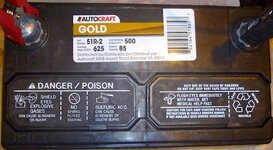Know the question is not relevant to those who prefer to view batteries as a time-based "consumable" and just change then periodically (like oil).
But can't imagine any negatives to checking - once past warranty.
Current battery still working well at four years. An Autocraft Gold which looks like a Johnson Controls unit. And, unless they are plastic-welded or otherwise bonded, looks like the covers could pop-off by prying with a flat screwdriver (photo below).
(Though admit that if it were one of those models where access was thoroughly hidden, probably wouldn't be getting an itch to at least take a peek at the level in each cell...)
But can't imagine any negatives to checking - once past warranty.
Current battery still working well at four years. An Autocraft Gold which looks like a Johnson Controls unit. And, unless they are plastic-welded or otherwise bonded, looks like the covers could pop-off by prying with a flat screwdriver (photo below).
(Though admit that if it were one of those models where access was thoroughly hidden, probably wouldn't be getting an itch to at least take a peek at the level in each cell...)

